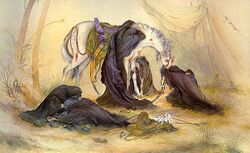Rawda-khwani
| Mourning of Muharram |
|---|
 |
| Events |
| Figures |
| Places |
| Occasions |
| Rituals |
Rawḍa-khwānī (Persian: روضهخوانی; translation: lament recitation) is a style of mourning in which the lamentations of Imam al-Husayn (a) and other Infallibles (a) are recited. Mourning ceremonies are also called "Rawdakhwani" ceremonies. In these ceremonies, the "Rawda-khwan" (lament reciter) sits on a minbar or a chair and loudly recites the elegies of an Infallible (a) in a sad voice. The entrance of the term, "rawda" and "rawda-khwani" into Shiite mourning literature traces back to the 10th/16th century when the book, Rawdat al-shuhada' was published.
Terminology
The word, "Rawḍa" (Arabic: روضة), literally means garden, heaven, paradise, and the like. Terminologically speaking, it refers to the recitation of the elegies of Imam al-Husayn (a) and other Infallibles (a) in prose. "Rawdakhwan" is a person whose occupation is the recitation of "Rawda". The mourning ceremony of Imam al-Husayn (a) is called "Rawdakhwani".
History
The entrance of the words "Rawda" and "Rawdakhwani" into the mourning literature of the Shi'as traces back to the 10th/16th century when the book, Rawda al-shuhada, was published. Al-Muhaddith al-Nuri who wrote the book, al-Lu'lu' wa l-marjan, about the conditions of a "Rawdakhwan", says: "such believers had no title [for such mourning ceremonies] … until Mulla Husayn al-Kashifi wrote the book Rawda al-shuhada".
Since reciters of the elegies read the stories of Karbala from the book, Rawda al-shuhada by Mulla Husayn al-Kashifi, what they did came to be called "Rawdakhwani", that is, the recitation of Rawda. Since they literally read the book, Rawda al-shuhada, to people, they were called Rawdakhwan, that is, reciters of the book, Rawda al-shuhada. The word, "Rawda" began to refer to the elegy of Imam al-Husayn (a), and the word, "Rawdakhwan", began to refer to someone who recites the Imam's (a) elegies, even if he did not read it from, or consulted, the book, Rawda al-shuhada.
In the Safavid period, a "Rawdakhwan" did the job used to be done by reciters of "manaqib" (virtues), maddah, and reciters of elegies. Moreover, they replaced tale-tellers, reciters of maqtal, and even preachers. After this period, a "Rawdakhwan" was at once a preacher, an orator, and a reciter of elegies and tried to make people cry by prose and poetry. Some travel books written in this period point to the Rawda-khwani ceremonies.
In the Afsharid period, Nader Shah restricted mourning and "Rawdakhwani" ceremonies, but in the Qajar period, mourning ceremonies of Imam al-Husayn (a) thrived. Fath Ali Shah Qajar held "Rawdakhwani" ceremonies on some eves of Friday, especially in the months of Ramadan, Muharram, and Safar. Naser al-Din Shah Qajar also held "Rawdakhwani" ceremonies in Muharram months and was committed to attending the ceremonies. However, the unprecedented flourishing of ta'ziya and the construction of tekyeh diminished the popularity of "Rawdakhwani" such that it became less official than ta'ziya.
In the second half of his monarchy, Reza Shah Pahlavi announced people's religious rituals to be superstitious. After the Event of Goharshad, "Rawda" ceremonies were more and more restricted, and police officers were commissioned to prevent such ceremonies. In some cities, preachers and conductors of "Rawda" ceremonies were imprisoned.
Shaykh 'Abd al-Karim al-Ha'iri al-Yazdi, the founder of the Islamic Seminary of Qom, contributed to the popularity of "Rawdakhwani" ceremonies. He prohibited ta'ziya in Qom and turned big ta'ziya ceremonies into "Rawdakhwani" ceremonies.
In the period of the second Pahlavi, women "Rawdakhwani" ceremonies at homes particularly flourished such that the activities of some women preachers were extended to bigger ceremonies outside homes. One prominent such woman in Tehran was Sharifa Katuziyan (the then-headmaster of "Din-u Danish" elementary school).
Procedure
"Rawdakhwani" is held during the anniversaries of the martyrdom of the Infallibles (a), especially in Muharram and Safar months. They are held in houses, husayniyya, tekyeh, mosques, and other places. The "Rawdakhwan" sits on a minbar or a chair, and tries to make the audience cry by reciting the elegies of Imam al-Husayn (a) and other Imams (a) in a sad voice. There are two types of "Rawdakhwan": preachers (wa'iz) and reciters (dhakir). The former usually deliver a sermon on the minbar before "Rawda", and at the end of the sermon, they recite the elegies of an Infallible (a), but the latter only recite the elegies.
"Rawdakhwani" ceremonies are held both for men and women. Women attend some men's ceremonies. However, in women's ceremonies, only women attend.
Propagation of Shiite Beliefs
"Rawdakhwani" has been influential in the establishment and introduction of the elegies of the Shiite Imams (a) and the Martyrs of Karbala. Imam Khomeini believed that "Rawdakhwani" has preserved the path of Sayyid al-Shuhada (a). It played, he holds, a crucial rule in the protection of Shiism.
References
- The material for this article is mainly taken from روضهخوانی in Farsi Wikishia.

